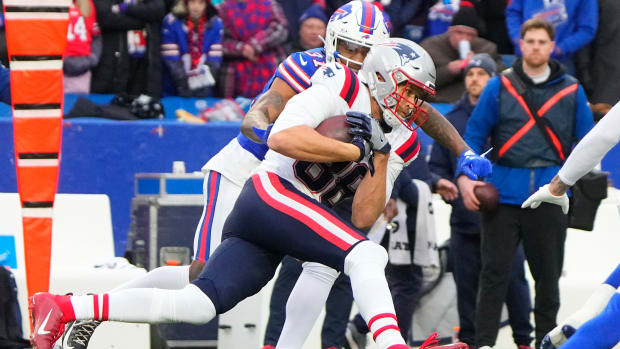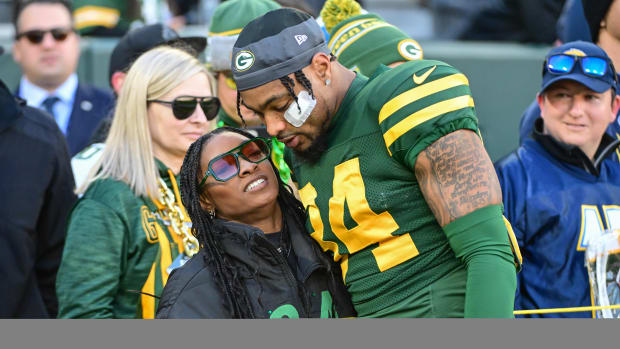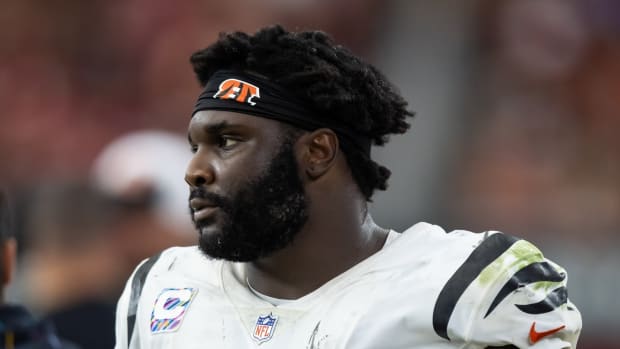Mac Jones’s First Impression
When Peyton Manning texted Mac Jones in early December, the rookie quarterback took a screenshot. He promptly shared it, but not with the person whom you might expect: It went to Stacey James, the Patriots’ vice president of media relations.
Jones, like most others of his age and position, would have been enthused to hop on the phone with the Hall of Fame quarterback turned broadcaster. But, as Manning shared on the ManningCast during New England’s Week 13 Monday night game in Buffalo, the 23-year-old needed permission from his team. That permission was denied from the top. Still wanting to help as much as he was able, James offered to set up an interview for Manning with … any veteran player? The Patriots’ longtime PR lead explained in a text to Manning: “Our rookies are harder to find than most witness protection programs.”
That’s standard practice for Bill Belichick’s organization, but it’s also been part of the team’s plan to bring along Jones—the only quarterback Belichick has ever selected in the first round—at a measured pace, with long-term success in mind. After the sub-.500 season in 2020, giving the Patriots the draft pick they’d use on Jones, they readied their roster for a rookie QB. They acquired expensive targets in free agency; bucked modern football convention by building a power run game with a physically imposing offensive line and an anachronistic fullback; and merged old and new pieces into a bend-don’t-break defense that, despite some late-season stumbles, leads the league in points allowed.
During the brief span in December when the Patriots sat atop the AFC again, the speed of the post–Tom Brady rebuild, with Jones as a linchpin, surprised even some members of the organization. Then, in two crucial conference games, Jones finally hit his rookie wall: He threw his first red-zone interception in the loss to the Colts and his completion rate plunged below 50% in the second matchup with the Bills. Still, Jones has had far and away the most successful rookie season of any QB in his draft class—as the high-floor prospect who was the fifth quarterback off the board.
Given how long it took the NFL to embrace and properly value quarterbacks whose movement skills have changed the way the position is played, it feels foolish to suggest that a pocket passer could prompt any sort of reconsideration of how QBs are evaluated. But those were some of the calls Jim Nagy, the former Seahawks scout who now runs the Senior Bowl, fielded from inside team facilities amid the Patriots’ seven-game winning streak that propelled them into contention and set up their return to the postseason.
“He’s reinforcing that there doesn't need to be a complete departure from how we looked at the quarterback position,” Nagy says of Jones. “Now, is it great when you have an athlete? Sure it is, because they open up so many other other opportunities. But Mac brought us back to where we had been in the past, that you can still win with that kind of guy.”
How much the Patriots can win with Jones is yet to be determined, and the answer won’t come from a one-season sample size. But this era for the Patriots is not only about Belichick proving he can win without Brady—it’s also about whether he can do so with a quarterback who is, stylistically, like Brady, at a time when a new generation of stars at the position play a much different game. And the rest of the league is watching closely.
Before Jones was an opening-day rookie starter for the most successful pro sports franchise of this century, he was waiting his turn at college football’s most successful program. During the two-and-a-half seasons he spent at Alabama sitting behind Jalen Hurts, and then Tua Tagovailoa, he had plenty of time to master what has been one of the primary reasons he’s been able to play right away in the NFL: his preparation.
Butch Jones, the current Arkansas State coach who was an assistant at Alabama for three years, recalls Jones drawing out entire game plans by hand in a notebook. Sketching out the details, from the quarterback’s drop to the depths of the receivers’ routes to the protection up front, was how he dissected and learned every play, even before he was the one who had to run them in games. Logan Burnett, one of the quarterbacks who shared a meeting room with Jones during the 2020 season—Jones’s only one as a full-time starter—watched his teammate take this same approach for new concepts added in-season. Often Alabama would change the window dressing to make the same plays look different in order to create better matchups and get their best players open—a foundational tenet of how the Patriots run their offense, too. Instead of lining up in a 3x1 formation, they’d start in 2x2 and then motion to 3x1; or they’d add new wrinkles like a jet sweep or play-action. Jones would draw these out, committing the new version to memory and tracing out the mismatches that might be created.
“A lot of it is a byproduct of his preparation,” Butch Jones says. “He’s willed himself into having the kind of success that he's having right now.”
With more pressure than ever for teams to play their high draft picks, young quarterbacks who do have elite movement skills have the advantage of being able to escape when protection breaks down or create time for second-reaction plays. There’s also been the reimagining of NFL offenses as spread concepts from the high school and college ranks—along with the players who learned in those systems—trickled up. Those factors led to predictions like the one Jordan Palmer, the private quarterbacks coach for a number of young passers, made last year in a profile on Josh Allen written by SI’s Greg Bishop: that Josh Rosen, drafted 10th overall in 2018, would be “the last quarterback who will ever be taken high in the draft whose main attribute is not movement.”
For the record, Burnett asserts that Jones routinely won the post-practice sprints at Alabama among the big skill player group, which included tight ends and linebackers. And his 40-yard dash time, clocked around 4.8 at Alabama’s pro day, was not as legendarily slow as Brady’s 5.28 seconds. Of course, no one would argue that Jones’s main attribute is movement, but his time at Alabama allowed him to develop other capabilities that made up the difference—so-called compensating factors.
Jones stayed put behind Hurts and Tagovailoa, rather than transferring to another program for an immediate opportunity to play. That was partly because he recognized that he needed to develop, both mentally and physically. And because Nick Saban’s program has become a waypoint for coaches between jobs, particularly on the offensive side of the ball, Jones was exposed to a melange of different offensive approaches and theories. The Crimson Tide had three different offensive coordinators in Mac Jones’s time there. The last was Steve Sarkisian, whom Burnett remembers using Patriots film of Brady and Rob Gronkowski to teach a play-action pass play where the QB dumps the ball off quickly to the TE about 10 to 12 yards down the middle of the field. (They watched this dozens of times, Burnett says, enough to make him confident in having spotted Jones running the same concept this season for New England.)
In the summer of 2020, Jones was preparing to be Alabama’s starting QB for a season that was up in the air due to the COVID-19 pandemic. The NCAA approved rules for summer workouts that started off with a set number of hours designated only for strength and conditioning work and film study. Jones had only started four college games at that point, but he became the ringleader of ad hoc player-run workouts, where they would take to the field by themselves to practice the plays their coaches had installed in the classroom that day.
They weren’t just tossing the ball around. They’d line up, sometimes seven-on-seven or other times with all 11 offensive players vs. air, and Jones would call out one of the plays they’d learned that day. But Jones would take it a step further, throwing out different scenarios that they might see in a game. For instance, if a free blitzer was coming off the edge against a certain play, how would you check the protection or alert the receiver to change his route? This work was necessary, because Jones would carry these responsibilities in a game. The verbiage at Alabama was akin to what is used at the professional level: Play calls were eight to 15 words long, Burnett explains, with front-side and back-side concepts, tags for any adjustments to be made based on the defense, plus the protection and any add-ons like play-action or motion.
Burnett began his college career at Mississippi State, where he was a freshman when recent graduate Dak Prescott won Rookie of the Year with the Cowboys. He recalls then-head coach Dan Mullen saying that the advanced pre-snap responsibilities Prescott held in college helped him thrive right away in the pros, something Burnett has thought about while watching Jones this season. He also experienced more personally Jones’s depth of understanding: Burnett transferred to Alabama just weeks before the 2020 summer workouts began, so it was a scramble to learn a new offense. Jones took the time to translate Alabama’s jargon to the systems Burnett had previously played in and even coached him through his third- and fourth-string reps.
“I’d never seen a player-led practice or workout run the way that it was run at Alabama,” Burnett says. “It was unbelievable. It was just like Coach Saban was on the field.”
When Mac Jones arrived for the Senior Bowl week in January 2021, just days removed from throwing for 464 yards and five TDs in Alabama’s national championship game victory against Ohio State, Nagy says the feedback he was getting from teams was that Jones was a late-first-round or early-second-round pick. But his years of preparation at Alabama showed up from the first day on the practice field, in front of talent evaluators from every NFL team.
Nagy, who has run the last three Senior Bowls, says it’s common for quarterbacks to look out of their depth in their first practices run by NFL coaching staffs. Many quarterbacks in college are reliant on plays being signaled in on cue cards from the sidelines, so getting into the huddle and getting a wordy play call out is a new experience. Nagy also says he often sees the QBs struggle with getting the ball out of their hands quickly and on time. “Of my three years here, [Jones] was the first guy that looked in full command on day one,” he says.
By the time San Francisco traded up to the No. 3 overall pick in late March, with the clear intention of taking a quarterback, Jones being taken off the board near the top of the first round seemed like a real possibility. Ultimately, though, he went behind four other quarterbacks: Trevor Lawrence, Zach Wilson, Trey Lance and Justin Fields. Each of these players, to varying degrees, has mobility as a primary part of their skillset.
“You’ve started to see guys really get knocked for that lack of mobility and pure athleticism,” Nagy says. “I think people will just be a little more careful not to ding those guys as much, if they have kind of the compensating factors that Mac has, and that’s instincts, football intelligence, accuracy. Those are compensating factors for the lack of a true dual threat.”
Belichick, given his longtime friendship with Saban, almost certainly had greater insight into the extent of those compensating factors. And the Patriots offered a situation for Jones that gave him the best chance to succeed: a stable organization with a track record of success; a strong supporting cast; a clear plan for how to develop a rookie quarterback, from limiting his media exposure (Sports Illustrated’s interview request, like Manning’s, was declined) to identifying things Jones can improve at on a weekly basis. Offensive coordinator Josh McDaniels explained in a press conference earlier this season, “Short term, let’s try and fix A, B and C this week. Long term, we want to get to D, E, F and G a month or two from now.” It may sound simple, but many organizations get this wrong.
There have been times on the field this season when Belichick and McDaniels have seemed intent on not putting too much on the rookie too soon. Notably: the decision in the final minute of Brady’s Foxboro return, with the Patriots trailing by two points, to attempt a 56-yard field goal in the driving rain rather than go for it on fourth-and-3 from the Tampa 37-yard-line. The kick, as you almost certainly are aware, doinked off the left upright. And, of course, Jones’s total of three pass attempts in the windswept win at Buffalo. But even as Jones’s performance sagged in the back-to-back losses that knocked the Patriots out of the AFC East lead, there were moments that sparked optimism: the 43-yard pass he launched to N’Keal Harry while the pocket collapsed to keep the game alive late in the fourth quarter against the Colts, or his fourth-and-3 completion to Jakobi Meyers against the Bills, on which Jones rolled right and directed his receiver to an open window on the field.
Marc Ross, the Giants college scouting director for their last two Super Bowl teams, is among those who needs to see more from Jones. “He’s doing relatively well, probably beyond expectations of some, but it’s still, how far can he take them? Will he get figured out? Or will the Patriots offense get figured out?” he says. “The ultimate success for him is the playoffs, when they get to the more high-stakes kind of games of, all right, is this legit? Can we operate like this?” What Nagy is predicting, though, is a subtle recalibration of quarterback evaluations—a recognition that maybe things swung too far the other direction.
Perhaps the salient takeaway from Jones’s rookie season is even more simple. Belichick and the Patriots are not out to prove they can win with a pocket passer: They already won six Super Bowls with one. But what they’ve done this year is take the quarterback that was there, identify and nurture the things that he does well and, rather than worry about what he can’t do, win games based on what he can.
• The Problems With the Deshaun Watson Investigation
• A Quarterback Evolution and a Coaching Revolution
• Solidarity and Betrayal: A Look Back at Baseball’s First Labor War








































